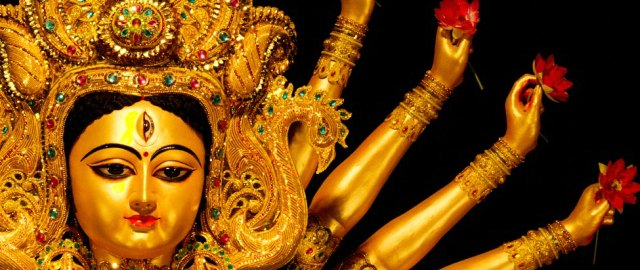
Kolkata
After the temple tour of Orissa, we got to Kolkata by train and arrived late in the evening. As we walked out of Howrah station towards the prepaid taxi stand, I was pleasantly surprised to see an organized railway station, with a nice British-era facade and relatively clean platforms. For some reason, my mind had always conjured an image of Kolkata with large crowds, crumbling old buildings, filth and beggars just like, if not worse than, in Mumbai. Over the following few days of our stay, this image was slowly but surely swept aside¦
Formerly known as Calcutta, Kolkata was the capital of British India until 1911. This accounts for some of the city’s fabulous colonial architecture and stone-paved alleys which are not unlike any European town except for the population, of course! It is considered to be the hub of India’s art and culture scene containing the country’s most politically aware intelligentsia! Over the years, since the poverty caused by partition and influx of refugees, the city has slowly regained its footing with a growing IT industry and manufacturing sector.
We found a comfortable hotel in a small alley at the south end of Chowringhee area, which was known as the ‘White Town’ pre-independence, as this was where the British gentry resided. The area is, today, quite a nice residential one and gave us a glimpse of regular life in the city.
On our first day out, we took a cab to Kolkata’s most famous edifice, the Victoria Memorial. But before that, a word about Kolkata’s cabs: 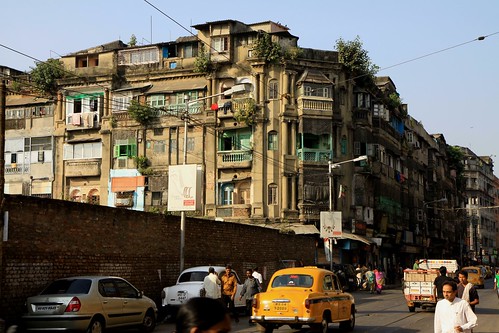 they are all yellow, Ambassador cabs with functioning meters and reasonable rates. And they are everywhere! In fact a quick look of Kolkata’s streets will show more yellow, rotund vehicles than private vehicles an Indian version of the streets of New York . Having traveled so much in auto-rickshaws and cabs all over India, we’ve always maintained that aamchi Mumbai’s honest auto-rickshaw drivers are the best of the lot. They almost never demand off-the-meter rates or round up meter-fares as is done elsewhere. Only in Kolkata have we found the cabbies to be of a similar disposition!
they are all yellow, Ambassador cabs with functioning meters and reasonable rates. And they are everywhere! In fact a quick look of Kolkata’s streets will show more yellow, rotund vehicles than private vehicles an Indian version of the streets of New York . Having traveled so much in auto-rickshaws and cabs all over India, we’ve always maintained that aamchi Mumbai’s honest auto-rickshaw drivers are the best of the lot. They almost never demand off-the-meter rates or round up meter-fares as is done elsewhere. Only in Kolkata have we found the cabbies to be of a similar disposition!
The Victoria Memorial Hall was built in 1921 as a memorial to Queen Victoria after her death in 1901. It’s a gorgeous monument of Indo-Saracenic architecture and built of white Makrana marble brought from 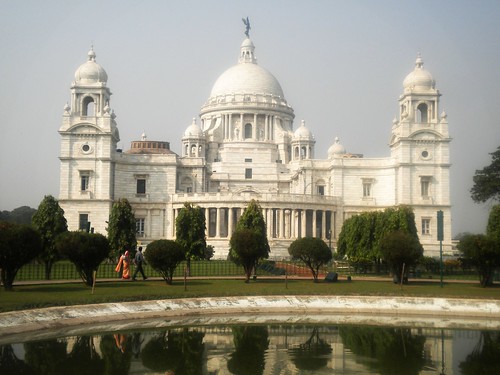 Rajasthan. It is set within a beautiful park landscaped with flowering shrubs, water features and large, shady trees. Visitors can gain access to just the park for Rs.4 each or a ‘Museum’ ticket of Rs.10 each allows access to both the park and the monument. The ground-floor halls of the monument have a large collection of British-era memorabilia, paintings and portraits of the British royal family and informative displays on India’s struggle for independence; a tad bit too informative – got tired after a while. At the park’s southern end is a small, self-service canteen where we had a nice (and cheap!) breakfast of coffee, egg-rolls and thick, soft toasts.
Rajasthan. It is set within a beautiful park landscaped with flowering shrubs, water features and large, shady trees. Visitors can gain access to just the park for Rs.4 each or a ‘Museum’ ticket of Rs.10 each allows access to both the park and the monument. The ground-floor halls of the monument have a large collection of British-era memorabilia, paintings and portraits of the British royal family and informative displays on India’s struggle for independence; a tad bit too informative – got tired after a while. At the park’s southern end is a small, self-service canteen where we had a nice (and cheap!) breakfast of coffee, egg-rolls and thick, soft toasts.
Right across from Victoria Memorial’s northern entrance is the Maidan, Kolkata’s largest green space! It’s a sprawling stretch of land with numerous playgrounds and also includes the famous Eden Gardens cricketing venue. In fact, the Victoria Memorial grounds are also considered to be part of the Maidan. Wide, well-built and well-maintained avenues bisect and surround the space, giving the city a great architectural feel, which is hard to find elsewhere in the country.
Southeast of Victoria Memorial, within walking distance, is the lovely St. Paul’s Cathedral. When we got there it was around 1pm and to our disappointment we found the church doors closed; they would reopen only at 3pm. So we had to return later in the evening and it was well worth the effort; not only does the church have a fabulous, white facade but the interiors are absolutely gorgeous too! Unfortunately, a school group was rehearsing for a play on a dais just before the main altar so the peace of visiting a church was completely ruined.
Just by the church, on the same road, is the lovely Academy of Fine Arts. It holds exhibitions and sales of work by local artisans, which are definitely worth a look. However, to our luck, during our visit, they were also holding an exhibition of paintings by children between the age of 11 and 17. When we entered the exhibition hall, we were handed a sheet listing all the paintings and the names of the artists. We were then asked to pick 5 of our favorite paintings from the lot, tick them off on the list and deposit the sheet in a collection box. The artist with the maximum votes would get a prize and scholarship from the academy . We were thrilled to browse the paintings especially since they were exceptionally good; it was really hard to pick just 5 amongst them. But we did pick them and thoroughly loved the experience! One extremely talented kid must have deservedly won that prize by now¦
From Kolkata we intended to visit the Sunderbans Wildlife Reserve as well. 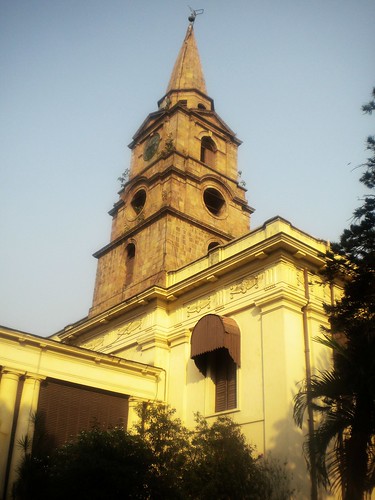 To book a room in the state government’s tourist lodge there, one has to call their office at Kolkata’s BBD Bagh area. We tried calling but couldn’t reach them, so we decided to visit the office personally. It turned out to be quite a nice office, well-staffed and with a lot of information. We made our bookings and then headed out to simply walk around and enjoy the area. Our guidebook suggested a walking route, which took us past some fabulous British-era buildings including a lovely church: St. John’s Cathedral. Further southeast we passed the magnificent High Court edifice and finally got to the ghats from where ferries ply the Hooghly River. From here we got a lovely view of the famed Howrah Bridge.
To book a room in the state government’s tourist lodge there, one has to call their office at Kolkata’s BBD Bagh area. We tried calling but couldn’t reach them, so we decided to visit the office personally. It turned out to be quite a nice office, well-staffed and with a lot of information. We made our bookings and then headed out to simply walk around and enjoy the area. Our guidebook suggested a walking route, which took us past some fabulous British-era buildings including a lovely church: St. John’s Cathedral. Further southeast we passed the magnificent High Court edifice and finally got to the ghats from where ferries ply the Hooghly River. From here we got a lovely view of the famed Howrah Bridge.
While walking the streets of Kolkata, one thing we couldn’t ignore was the row upon row of food stalls serving up everything from momos to jalebis and tea to lassis. And to our amazement, each one of these stalls buzzes with business during lunch hours when office-goers from surrounding areas converge on them for a quick and cheap meal. Mumbai has quite a bit of street food as well, especially those serving chaat, but I think Kolkata beats it hands down just by the sheer size of its patronage and the variety of food on offer; it felt like a food-lover’s paradise ! During our stay Madhu and I sampled quite a bit of this and are proud to say that our stomachs enjoyed it without a grumble! We ate Puchkas (Bengali word for Mumbai’s Pani-puris and Delhi’s Gol-gappas) from a stand across the street from the Academy of Fine Arts and I must admit that they were unbelievably yummy! On Elgin road in the Chowringhee area, we ate Chowmein, Dosas, Idlis, and Kathi Rolls from the streets and loved them all; they completely enhanced our Kolkata experience!
On our second day in town we visited Kolkata’s Indian Museum, which is considered to be the largest of its kind in the country. And this is mainly because it houses everything from archaeological sections to zoological and botanical ones. It was first established in 1814, making it one of the oldest in the Asia-Pacific region and was housed in the Asiatic Society’s building. It was transferred to the current location, which is a lovely colonial three-storied mansion, in 1878. Its interiors look dusty and a little run-down today but the collection is quite awe-inspiringly huge. We loved the paintings section the best, loved the architecture of the mansion and found the Natural History section to be a little sad – overall it was an interesting visit!
A little south and west of the museum is Kolkata’s famed Park Street. It is known for its concentration of live-music venues, night clubs and high-profile restaurants. It’s a lovely avenue to walk through with stores and restaurants on either side with a great rush of Kolkata’s youth patronizing them; a great place for people-watch ! We ambled through here and found the fabulous Oxford Bookstore, which had a huge collection of everything including travel books and music CDs. We spent a while browsing through it, made a couple of purchases and then retired to their ‘Cha Bar’ upstairs where we lunched on chicken sandwiches, quiches and several cups of the best tea; an afternoon well-spent!
Nineteenth century Kolkata saw the building of fabulous mansions as homes for the wealthy Bengali land-owner or tradesman. They are spread around the northern parts of Kolkata, which was where the locals lived, away from the ‘white’ parts of town. Today many of these are in a poor condition but still in use 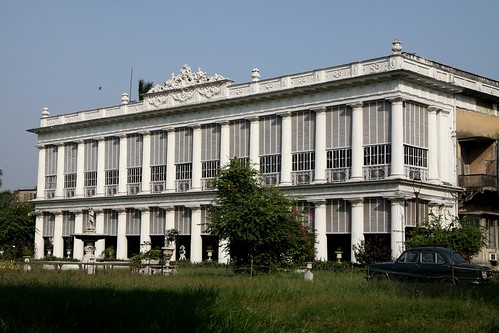 by the descendants of the family. A fabulous example of the Bengali’s love for royal residence is the unbelievably decadent Marble Palace. Built in 1835 by a wealthy Bengali merchant, the house is located in an unlikely, crowded alley off Rabindra Sarani in the Barabazaar area. Since it’s still privately owned and used by the merchant’s family, a written permission needs to be obtained from the state’s tourism office for entry. Large, wrought-iron gates, manned by lazy-looking security personnel fronts a beautiful, marble mansion that looks completely out of place in the chaotic surroundings. The green space around the mansion is poorly maintained and was a sad sight. For a small tip, a caretaker gave us a brief tour of the insides of the palace, which had an amazing collection of Belgium-glass chandeliers, lovely paintings, gorgeous sculptures and Victorian furnishings – must have been a nice life! But the sight of some exotic birds caged in filthy-looking enclosures irked us a bit. A ‘zoo’ of sorts with flamingoes, peacocks, barking deer and antelopes enclosed in cages at the eastern end of the mansion’s grounds was downright pathetic! I hope the government moves these poor birds and animals to a proper state zoo where they are bound to be better cared for by professionals than by untrained locals.
by the descendants of the family. A fabulous example of the Bengali’s love for royal residence is the unbelievably decadent Marble Palace. Built in 1835 by a wealthy Bengali merchant, the house is located in an unlikely, crowded alley off Rabindra Sarani in the Barabazaar area. Since it’s still privately owned and used by the merchant’s family, a written permission needs to be obtained from the state’s tourism office for entry. Large, wrought-iron gates, manned by lazy-looking security personnel fronts a beautiful, marble mansion that looks completely out of place in the chaotic surroundings. The green space around the mansion is poorly maintained and was a sad sight. For a small tip, a caretaker gave us a brief tour of the insides of the palace, which had an amazing collection of Belgium-glass chandeliers, lovely paintings, gorgeous sculptures and Victorian furnishings – must have been a nice life! But the sight of some exotic birds caged in filthy-looking enclosures irked us a bit. A ‘zoo’ of sorts with flamingoes, peacocks, barking deer and antelopes enclosed in cages at the eastern end of the mansion’s grounds was downright pathetic! I hope the government moves these poor birds and animals to a proper state zoo where they are bound to be better cared for by professionals than by untrained locals.
Further south on the Rabindra Sarani road is the renowned Bengali poet Rabindranath Tagore’s lovely home, simply called the ‘Tagore House‘. 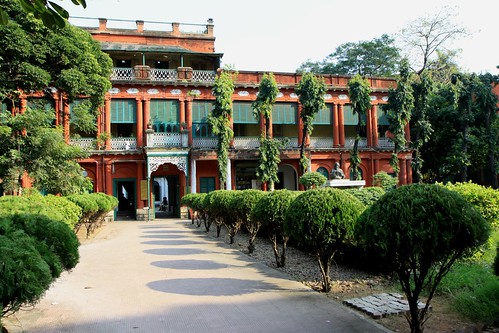 This is his birthplace and also his final resting place. The house is a gorgeous 3-storey structure with well-tended lawns in the front. It’s tucked away in a side-alley and therefore a little distanced from the chaos of the main street. The house now holds the poet’s memorabilia, informative displays of his life and work, and showcases the rooms used by him and his family. It was all quite well-maintained and nicely presented. An inner courtyard has a large platform at one end where Tagore staged many plays and performances for guests. At the other end of the same courtyard is a pretty, pillared portico. We loved this part of the house the most!
This is his birthplace and also his final resting place. The house is a gorgeous 3-storey structure with well-tended lawns in the front. It’s tucked away in a side-alley and therefore a little distanced from the chaos of the main street. The house now holds the poet’s memorabilia, informative displays of his life and work, and showcases the rooms used by him and his family. It was all quite well-maintained and nicely presented. An inner courtyard has a large platform at one end where Tagore staged many plays and performances for guests. At the other end of the same courtyard is a pretty, pillared portico. We loved this part of the house the most!
We had read about an interesting synagogue in the Barabazaar area and tried getting a taxi to take us there. But almost every cabbie we hailed refused and drove off in indignation. It was only after a cycle rickshaw dropped us off at the junction of Rabindra Sarani and Canning St in an unbelievably chaotic market with virtually no space to walk, forget drive or bike, did we understand the taxi drivers’ reluctance to come this way! It was the most crowded place Madhu and I had ever set foot in in our lives !
We walked west on Canning Street through the swarming crowds and immediately spotted the soaring spire of the Moghan David Synagogue at the junction of Brabourne Road. Its entrance was hidden behind a long row of street stalls selling knickknacks. The owner of the stall right in front of the closed 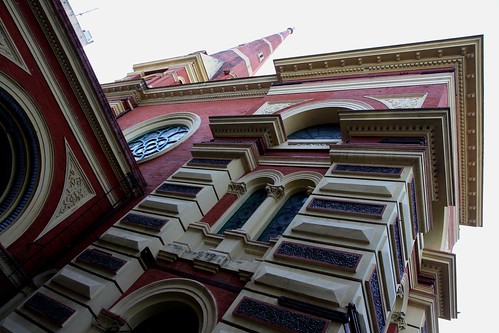 gates informed us that we would need permits to visit the place of worship. Since we didn’t know where to go to get the permit or how to go about it, Madhu used all his charm and convinced the stall owner that we just wanted a quick peek at the place. Reluctantly he and another friend opened the gates for us and also let us into the fabulous interiors of the synagogue. It was being renovated with a fresh coat of paint and new electrical work but the old, grand woodwork looked gorgeous and absolutely regal! The lower floor which housed the main altar was also the place where the men sit to pray. The women are seated upstairs along the 3-sided gallery that looks out to the prayer hall below. We couldn’t thank the two caretakers enough for their generosity and kindness in letting us see this wonderful place!
gates informed us that we would need permits to visit the place of worship. Since we didn’t know where to go to get the permit or how to go about it, Madhu used all his charm and convinced the stall owner that we just wanted a quick peek at the place. Reluctantly he and another friend opened the gates for us and also let us into the fabulous interiors of the synagogue. It was being renovated with a fresh coat of paint and new electrical work but the old, grand woodwork looked gorgeous and absolutely regal! The lower floor which housed the main altar was also the place where the men sit to pray. The women are seated upstairs along the 3-sided gallery that looks out to the prayer hall below. We couldn’t thank the two caretakers enough for their generosity and kindness in letting us see this wonderful place!
The Barabazaar area also has a Catholic Church and an Armenian one. While the Catholic Church wasn’t very unique, the Armenian one looked quite intriguing but was closed by the time we got there. It is located in a narrow alley in the midst of a wholesale market that sells office and school stationary in bulk – it was an interesting area to walk around.
On our last day in Calcutta we checked out of the hotel at 10am but left our bags there as our overnight train to Siliguri was to leave only at 8:30 at night. We spent most of the day at the INOX theatre inside Forum Mall on Elgin Road. The mall was quite nice and the theatre was really good. We watched two movies; one was a predictable Hindi romantic flick while the other was a beautifully shot English movie on a horse called the Secretariat – total paisa vasool!
Between the two movies, we found time to visit Netaji Bhawan, which is also on Elgin Road right across the Forum Mall. This was Netaji Subhash Chandra Bose’s ancestral home and is today a museum dedicated to displaying the life and works of this revolutionary freedom fighter. It was handed over to the government as a historic house by his elder brother Sharat Chandra Bose in 1947. The museum is not as nice as the one at Tagore house but has a lot of interesting information about the leader, including a display of his photographs and garments worn by him.
That night as we took our final cab ride in an yellow Ambassador to the Sealdah railway station, we realized that we had truly enjoyed our stay in this architecturally lovely city with its laid-back, smartly-dressed, friendly (if somewhat eccentric ) people and their crave for good art, music and food although, I think the ‘food’ part is what really won us over !


No comments yet.